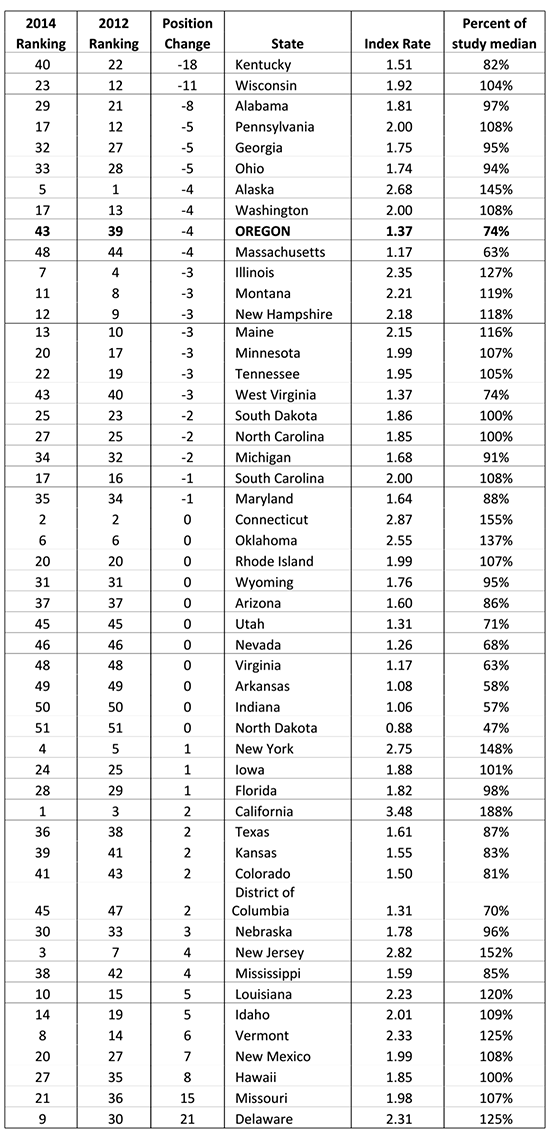 We can see that there were major drops in premium rank for both Kentucky and Wisconsin. Kentucky moved from 22nd-highest in the nation to 40th, improving by 18 positions. Wisconsin moved down 11 spots, from 12th-highest to 23rd. While Wisconsin did enact some changes in 2012, neither state is considered to have been a major reform state over the last few years.
For a couple of those states undergoing dramatic reforms, Oklahoma and Tennessee, it is too early to tell the effect, as they are just implementing changes this year. Others, however, including California and Kansas, saw premium costs as a comparative rise despite reforms intended to do otherwise. Illinois, another reform state, did see some positive movement, but it is probably not statistically significant given the weight of the costs and issues in that state.
I would postulate based on this report that people in New Mexico, Hawaii, Missouri and Delaware may be thinking of what changes should be in order, because they had dramatic negative movement on the scale this year. Even if past reforms overall are not creating significant improvement in these numbers, I am pretty sure they will be a better predictor of what states may be facing reform in the future.
Oregon has conducted these studies in even-numbered years since 1986, when Oregon’s rates were among the highest in the nation. The department reports the results to the Oregon legislature as a performance measure. Oregon’s relatively low rate today reflects the state’s workers’ compensation system reforms and its improvements in workplace safety and health.
Here are some key links for the study/workers’ compensation costs:
• To read a summary of the study, go here.
• Prior years’ summaries and full reports with details of study methods can be found here.
• Information on workers’ compensation costs in Oregon, including a map with these state rate rankings, is here.
We can see that there were major drops in premium rank for both Kentucky and Wisconsin. Kentucky moved from 22nd-highest in the nation to 40th, improving by 18 positions. Wisconsin moved down 11 spots, from 12th-highest to 23rd. While Wisconsin did enact some changes in 2012, neither state is considered to have been a major reform state over the last few years.
For a couple of those states undergoing dramatic reforms, Oklahoma and Tennessee, it is too early to tell the effect, as they are just implementing changes this year. Others, however, including California and Kansas, saw premium costs as a comparative rise despite reforms intended to do otherwise. Illinois, another reform state, did see some positive movement, but it is probably not statistically significant given the weight of the costs and issues in that state.
I would postulate based on this report that people in New Mexico, Hawaii, Missouri and Delaware may be thinking of what changes should be in order, because they had dramatic negative movement on the scale this year. Even if past reforms overall are not creating significant improvement in these numbers, I am pretty sure they will be a better predictor of what states may be facing reform in the future.
Oregon has conducted these studies in even-numbered years since 1986, when Oregon’s rates were among the highest in the nation. The department reports the results to the Oregon legislature as a performance measure. Oregon’s relatively low rate today reflects the state’s workers’ compensation system reforms and its improvements in workplace safety and health.
Here are some key links for the study/workers’ compensation costs:
• To read a summary of the study, go here.
• Prior years’ summaries and full reports with details of study methods can be found here.
• Information on workers’ compensation costs in Oregon, including a map with these state rate rankings, is here.Oregon Study Shows Which States Are Next
The workers' comp research suggests, for instance, that Missouri, New Mexico, Hawaii and Delaware may see major reform efforts soon.

 We can see that there were major drops in premium rank for both Kentucky and Wisconsin. Kentucky moved from 22nd-highest in the nation to 40th, improving by 18 positions. Wisconsin moved down 11 spots, from 12th-highest to 23rd. While Wisconsin did enact some changes in 2012, neither state is considered to have been a major reform state over the last few years.
For a couple of those states undergoing dramatic reforms, Oklahoma and Tennessee, it is too early to tell the effect, as they are just implementing changes this year. Others, however, including California and Kansas, saw premium costs as a comparative rise despite reforms intended to do otherwise. Illinois, another reform state, did see some positive movement, but it is probably not statistically significant given the weight of the costs and issues in that state.
I would postulate based on this report that people in New Mexico, Hawaii, Missouri and Delaware may be thinking of what changes should be in order, because they had dramatic negative movement on the scale this year. Even if past reforms overall are not creating significant improvement in these numbers, I am pretty sure they will be a better predictor of what states may be facing reform in the future.
Oregon has conducted these studies in even-numbered years since 1986, when Oregon’s rates were among the highest in the nation. The department reports the results to the Oregon legislature as a performance measure. Oregon’s relatively low rate today reflects the state’s workers’ compensation system reforms and its improvements in workplace safety and health.
Here are some key links for the study/workers’ compensation costs:
• To read a summary of the study, go here.
• Prior years’ summaries and full reports with details of study methods can be found here.
• Information on workers’ compensation costs in Oregon, including a map with these state rate rankings, is here.
We can see that there were major drops in premium rank for both Kentucky and Wisconsin. Kentucky moved from 22nd-highest in the nation to 40th, improving by 18 positions. Wisconsin moved down 11 spots, from 12th-highest to 23rd. While Wisconsin did enact some changes in 2012, neither state is considered to have been a major reform state over the last few years.
For a couple of those states undergoing dramatic reforms, Oklahoma and Tennessee, it is too early to tell the effect, as they are just implementing changes this year. Others, however, including California and Kansas, saw premium costs as a comparative rise despite reforms intended to do otherwise. Illinois, another reform state, did see some positive movement, but it is probably not statistically significant given the weight of the costs and issues in that state.
I would postulate based on this report that people in New Mexico, Hawaii, Missouri and Delaware may be thinking of what changes should be in order, because they had dramatic negative movement on the scale this year. Even if past reforms overall are not creating significant improvement in these numbers, I am pretty sure they will be a better predictor of what states may be facing reform in the future.
Oregon has conducted these studies in even-numbered years since 1986, when Oregon’s rates were among the highest in the nation. The department reports the results to the Oregon legislature as a performance measure. Oregon’s relatively low rate today reflects the state’s workers’ compensation system reforms and its improvements in workplace safety and health.
Here are some key links for the study/workers’ compensation costs:
• To read a summary of the study, go here.
• Prior years’ summaries and full reports with details of study methods can be found here.
• Information on workers’ compensation costs in Oregon, including a map with these state rate rankings, is here.






